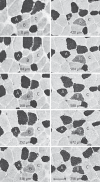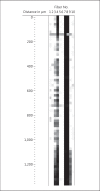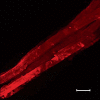Myosin Heavy Chain Expression Can Vary over the Length of Jaw and Leg Muscles
- PMID: 26950765
- PMCID: PMC5296893
- DOI: 10.1159/000443606
Myosin Heavy Chain Expression Can Vary over the Length of Jaw and Leg Muscles
Abstract
Muscle fiber type classification can be determined by its myosin heavy chain (MyHC) composition based on a few consecutive sections. It is generally assumed that the MyHC expression of a muscle fiber is the same over its length since neural stimulation and systemic influences are supposed to be the same over its length. We analyzed this in detail in three muscle types: the temporalis (closer) and digastricus (opener; both first brachial arch), and the medial gastrocnemius (somite). Sections of the muscles were incubated with monoclonal antibodies against various MyHC isoforms, and the distribution of these isoforms within individual fibers was followed over a distance of approximately 1 mm. The staining intensity of a fiber was measured and compared with the other fibers in the section. In the temporalis, digastricus, and gastrocnemius, 46, 11, and 15%, respectively, of their MyHC-I fibers showed a variation in the staining intensity over the length of their fibers, as well as 47, 87, and 22%, respectively, of their MyHC-IIA fibers. Most variable fibers were found amongst those with an overall relative intermediate staining intensity, which are presumably hybrid fibers. We conclude that different parts of a muscle fiber can have different fiber type compositions and, thus, contractile properties. Some muscle parts might reach their maximum contraction peak sooner or later than a muscle part a few microns further away. Next to stimulation by the nerve and systemic influences, local influences might also have an impact on the MyHC expression of the fiber.
© 2016 S. Karger AG, Basel.
Figures




Similar articles
-
Abundant expression of myosin heavy-chain IIB RNA in a subset of human masseter muscle fibres.Arch Oral Biol. 2001 Nov;46(11):1039-50. doi: 10.1016/s0003-9969(01)00066-8. Arch Oral Biol. 2001. PMID: 11543711 Free PMC article.
-
Myosin heavy-chain isoform composition of human single jaw-muscle fibers.J Dent Res. 2003 Jun;82(6):481-5. doi: 10.1177/154405910308200615. J Dent Res. 2003. PMID: 12766203
-
Myosin isoforms and muscle fiber characteristics in equine gluteus medius muscle.Anat Rec. 1996 Apr;244(4):444-51. doi: 10.1002/(SICI)1097-0185(199604)244:4<444::AID-AR3>3.0.CO;2-V. Anat Rec. 1996. PMID: 8694280
-
Fiber-type composition of the human jaw muscles--(part 2) role of hybrid fibers and factors responsible for inter-individual variation.J Dent Res. 2005 Sep;84(9):784-93. doi: 10.1177/154405910508400902. J Dent Res. 2005. PMID: 16109985 Review.
-
Specialized cranial muscles: how different are they from limb and abdominal muscles?Cells Tissues Organs. 2003;174(1-2):73-86. doi: 10.1159/000070576. Cells Tissues Organs. 2003. PMID: 12784043 Free PMC article. Review.
Cited by
-
Desmin gene expression is not ubiquitous in all upper airway myofibers and the pattern differs between healthy and sleep apnea subjects.Eur J Med Res. 2024 Apr 3;29(1):216. doi: 10.1186/s40001-024-01812-9. Eur J Med Res. 2024. PMID: 38566246 Free PMC article.
-
How to Build a Super Predator: From Genotype to Phenotype.Am Biol Teach. 2021 Mar;83(3):138-146. doi: 10.1525/abt.2021.83.3.138. Am Biol Teach. 2021. PMID: 34012167 Free PMC article.
-
Fiber type composition of epaxial muscles is geared toward facilitating rapid spinal extension in the leaper Galago senegalensis.Am J Phys Anthropol. 2018 May;166(1):95-106. doi: 10.1002/ajpa.23405. Epub 2018 Jan 10. Am J Phys Anthropol. 2018. PMID: 29318571 Free PMC article.
-
Spatial multi-omics in whole skeletal muscle reveals complex tissue architecture.Commun Biol. 2024 Oct 5;7(1):1272. doi: 10.1038/s42003-024-06949-1. Commun Biol. 2024. PMID: 39369093 Free PMC article.
-
Transitional Hybrid Skeletal Muscle Fibers in Rat Soleus Development.J Histochem Cytochem. 2019 Dec;67(12):891-900. doi: 10.1369/0022155419876421. Epub 2019 Sep 11. J Histochem Cytochem. 2019. PMID: 31510854 Free PMC article.
References
-
- Allen D.L., Harrison B.C., Leinwand L.A. Inactivation of myosin heavy chain genes in the mouse: diverse and unexpected phenotypes. Microsc Res Tech. 2000;50:492–499. - PubMed
-
- Andersen J.L., Mohr T., Biering-Sörensen F., Glabo H., Kjaer M. Myosin heavy chain isoform transformation in single fibres from m. vastus lateralis in spinal cord injured individuals: effect of long-term functional electrical stimulation (FES) Pfl¨gers Arch. 1996;431:513–518. - PubMed
-
- Armstrong R.B., Duan C., Delp M.D., Hayes D.A., Glenn G.M., Allen G.D. Elevations in rat soleus muscle [Ca2+] with passive stretch. J Appl Physiol (1985) 1993;74:2990–2997. - PubMed
-
- Bartnik B.L., Waldbillig D.M., Bandman E., Rosser B.W. Persistent expression of developmental myosin heavy chain isoforms in the tapered ends of adult pigeon pectoralis muscle fibers. Histochem J. 1999;31:321–329. - PubMed
-
- Bicer S., Reiser P.J. Myosin isoform expression in dog rectus muscles: patterns in global and orbital layers and among single fibers. Invest Ophthalmol Vis Sci. 2009;50:157–167. - PubMed
Publication types
MeSH terms
Substances
LinkOut - more resources
Full Text Sources
Other Literature Sources

